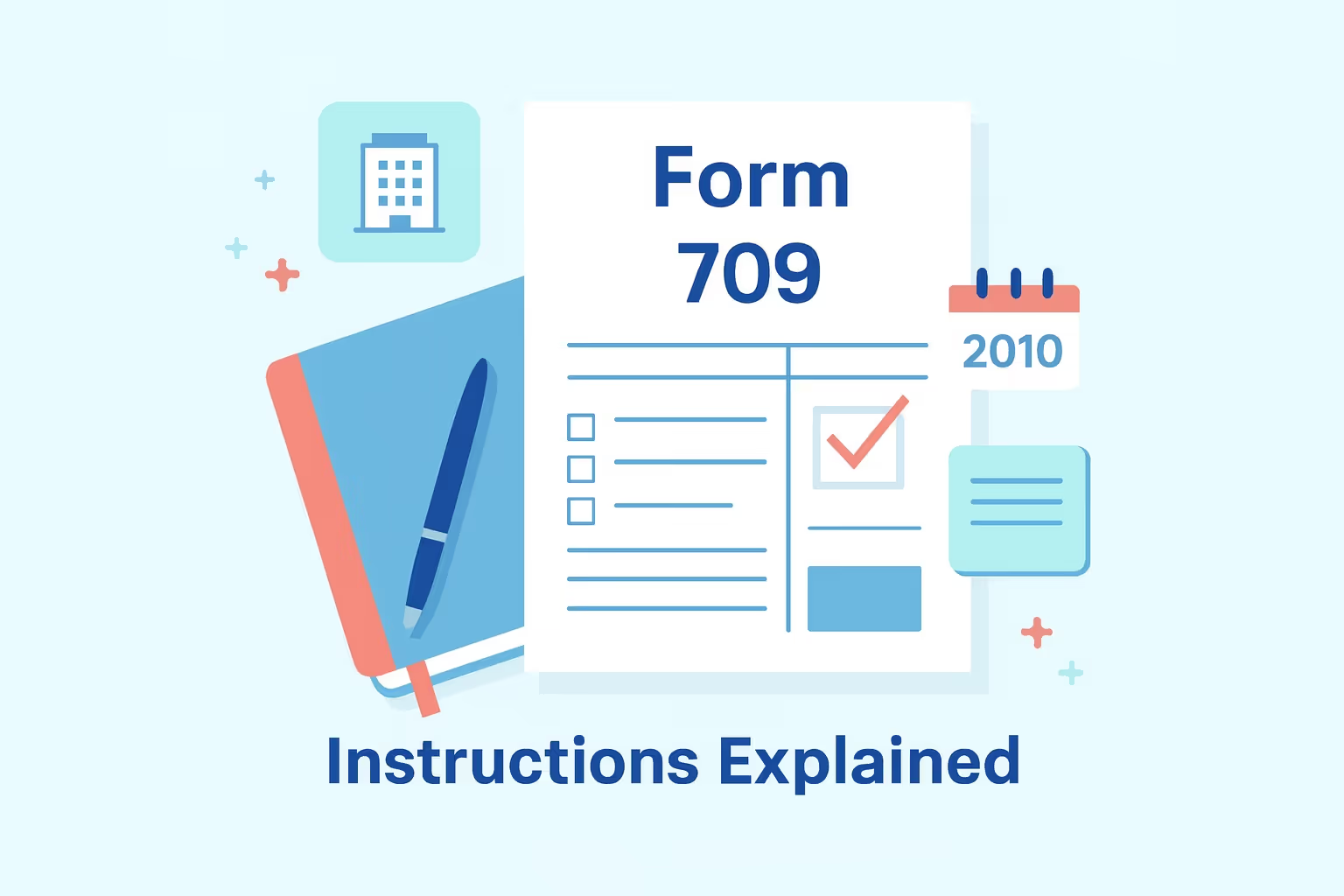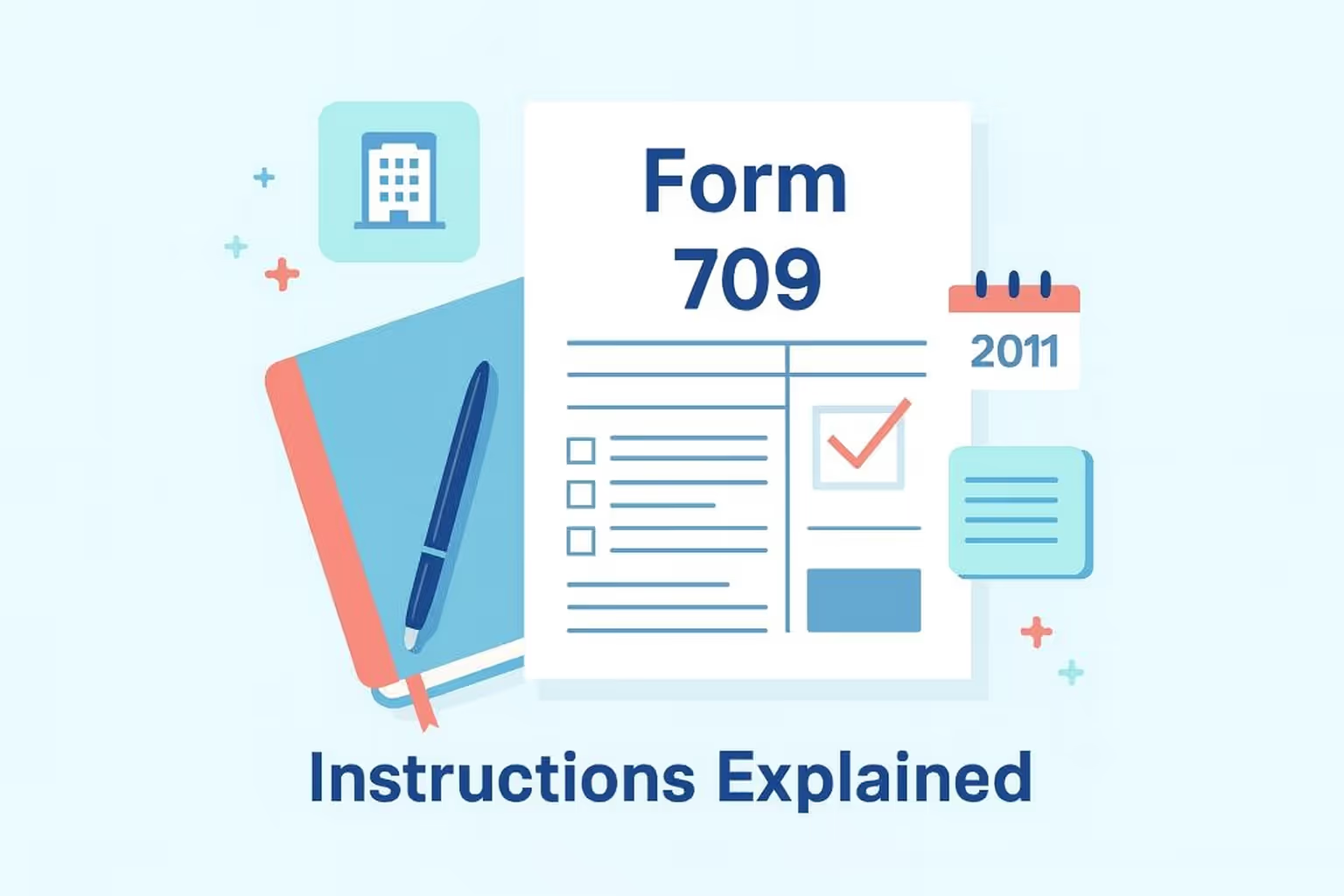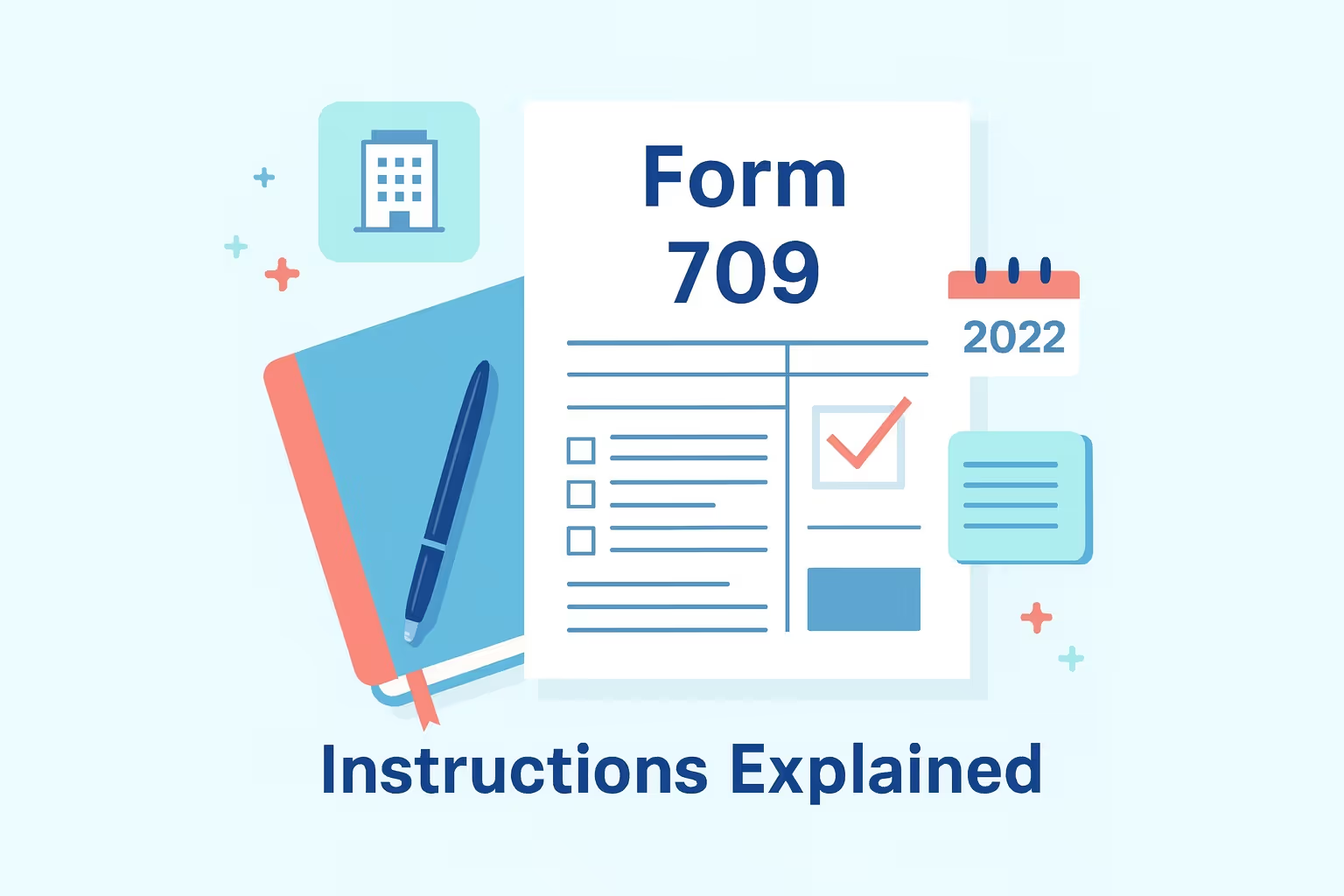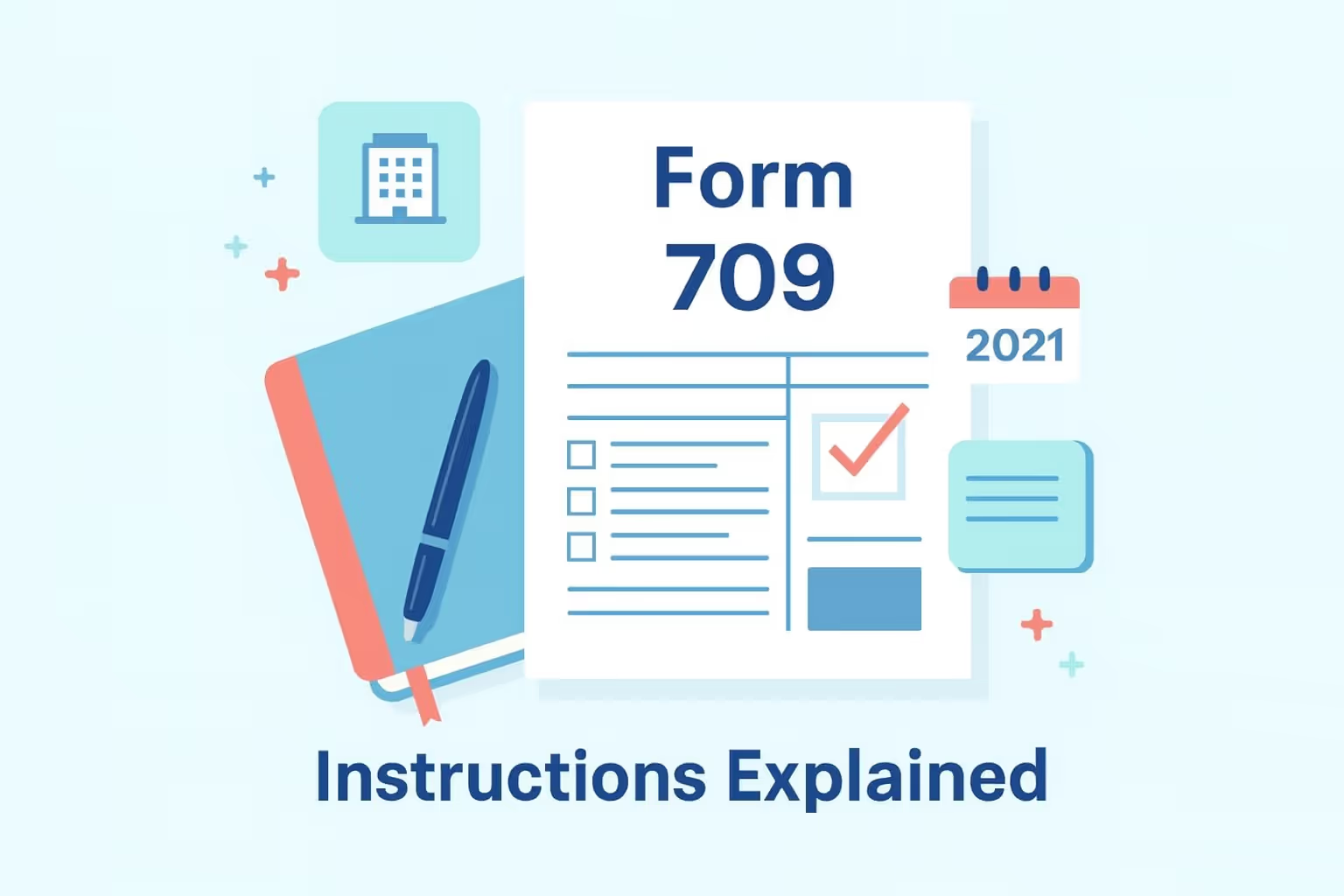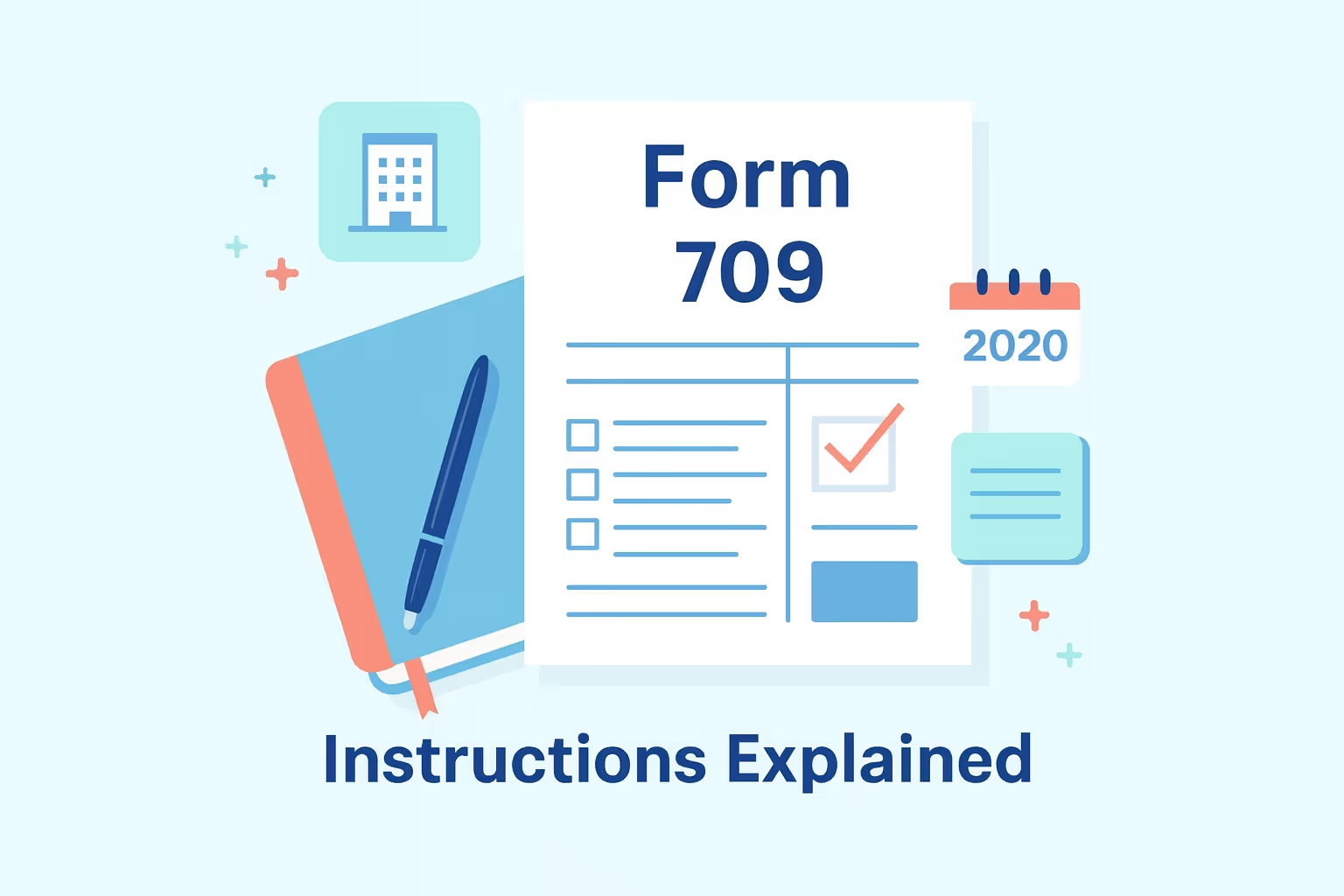Form 709 2018 Instructions: Federal Gift Tax Guide

Many taxpayers must file Form 709 for the 2018 tax year. The form, the United States Gift (and Generation-Skipping Transfer) Tax Return, allows you to report certain transfers and calculate applicable tax responsibilities. Although most people do not pay federal gift taxes, accurate reporting is required whenever specific conditions apply.
The Internal Revenue Service uses Form 709 to track annual and lifetime gifts. Even when the annual gift tax exclusion covers smaller transfers, larger or future interest gifts must be reported. The form also establishes how much of your lifetime gift tax exemption has been used, directly affecting your estate tax exemption.
Understanding the rules for taxable gifts, the annual exclusion amount, and how the generation-skipping transfer tax applies ensures compliance. This guide provides clear filing instructions, examples of when gift tax applies, and step-by-step directions for filing Form 709 properly.
Overview of Gift Tax and Form 709
Gift tax applies when a person transfers property, money, or tangible property without receiving equal value in return. Filing Form 709 ensures accurate reporting of taxable gifts and protects future estate planning opportunities. It records taxable transfers above the annual exclusion amount and applies toward the lifetime gift tax exemption.
Primary Gift Tax Purposes
- Report taxable gifts: The form reports any transfer above the annual exclusion, including future interests and certain transfers of tangible property.
- Allocate lifetime exemption: Form 709 calculates the lifetime gift tax exemption directly reduced for future estate tax purposes.
- Apply exclusions and deductions: Taxpayers can claim the annual gift tax exclusion and marital and charitable deductions to reduce taxable amounts.
- Track generation skipping transfer tax: Transfers skipping a generation, such as grandparents to grandchildren, must be reported to calculate the appropriate tax.
Who Must File Form 709
- Annual gifts exceeding exclusion amount: In 2018, a gift above the $15,000 annual exclusion amount requires reporting on a separate return.
- Future interests in property: Any transfer where the recipient cannot immediately use or enjoy the property qualifies as a taxable gift for gift tax purposes.
- Married couples splitting gifts: When married couples elect to split gifts, each spouse must file Form 709, even if only one person made the transfer.
- Transfers affecting estate planning: Lifetime gifts that use the lifetime exemption or create generation-skipping transfer obligations must be reported for accurate estate tax records.
Key Exclusion Amounts for Tax Year 2018
- Annual gift tax exclusion: $15,000 per person, per calendar year, for each gift of present interest made to a recipient.
- Annual exclusion for non-citizen spouse: $152,000 in 2018 for transfers of cash or property to a spouse who is not a U.S. citizen.
- Lifetime exemption: In 2018, the $11.18 million lifetime gift tax exemption was available for U.S. citizens, impacting the estate tax exemption.
- Gift tax rates: In 2018, the highest rate for federal gift taxes was 40 percent on the total amount above applicable exemptions.
What Changed in 2018 for Gift and Generation Skipping
Taxpayers must note that the Tax Cuts and Jobs Act created significant changes for 2018. The annual exclusion increased, and the lifetime exemption amounts doubled. These changes reduced how often the gift tax applies and changed filing expectations.
Annual Gift Tax Exclusion Increase
The annual gift tax exclusion increased from $14,000 in 2017 to $15,000 in 2018, allowing taxpayers to give larger, tax-free gifts to each recipient.
Estate Tax Exemption and Lifetime Exemption
Under the new law, the estate tax exemption doubled, raising the lifetime gift tax exemption to $11.18 million. Fewer taxpayers reached taxable thresholds.
Filing Form Location Changes
- Cincinnati address: Paper returns for Form 709 in 2018 were mailed to the Internal Revenue Service Center in Cincinnati, Ohio.
- Private delivery services: Deliveries sent through designated carriers went to the IRS office in Covington, Kentucky, instead of a P.O. box.
Generation Skipping Transfer Adjustments
Generation-skipping transfer tax rules continued to apply, but higher exclusion amounts meant fewer taxpayers needed to pay tax. Reporting was still required to establish exemption use.
Step-by-Step Form 709 2018 Instructions
Form 709 requires careful preparation to correctly report every taxable gift, exclusion, and deduction. A structured step-by-step process helps avoid mistakes when filing Form 709 with the Internal Revenue Service.
Step 1: Gather Required Information
Gather personal details, including your Social Security number, legal residence, and citizenship status. Collect descriptions of each gift, the date, fair market value, and recipient details. Attach supporting documents such as appraisals, contracts, or financial statements to confirm accurate valuations. Preparing this documentation ensures precise reporting and smooth application of the annual exclusion and lifetime exemption.
Step 2: Complete the General Information Section
This section records taxpayer identification, residence, and citizenship status. Indicate if an automatic or other extension has been requested, but remember extensions apply only to filing taxes, not payment. Note any previous Forms 709 filed and confirm address changes. Providing accurate information ensures proper IRS processing and helps avoid rejections or delays caused by incomplete or inconsistent taxpayer details.
Step 3: Gift Splitting Election
Gift splitting allows married couples to double the annual exclusion amount for each recipient. Each spouse must consent to split all gifts for the calendar year and file a separate return to confirm the agreement. Both must be U.S. citizens or residents and married when the gift occurs. If one spouse remarries in the same year, gift splitting is prohibited.
Step 4: Complete Schedule A
Schedule A records all taxable gifts and divides them into categories. Regular gifts must be listed separately from direct or indirect skips, each with accurate descriptions, valuation methods, and transfer dates. Regular gifts are reported as taxable transfers subject only to the gift tax, while direct and indirect skips are subject to the generation-skipping transfer tax rules. Appraisals or valuations must always be included for accuracy.
Step 5: Apply Exclusions and Deductions
Exclusions and deductions reduce taxable gifts before tax is computed. Apply the $15,000 annual exclusion for each recipient, ensuring each gift qualifies as a present interest. Spousal deductions apply without limit for gifts to a U.S. citizen spouse, while charitable deductions apply to qualifying charities. Future interests never qualify for the annual exclusion and must always be fully reported on Form 709.
Step 6: Compute Gift Tax
This section calculates gift tax liability after exclusions and deductions. Add current year taxable gifts and combine them with prior years’ totals. Use the IRS tax tables to determine tentative liability before applying credits and exemptions. Apply the lifetime exemption to offset taxable gifts and subtract credits from previous years. Report any generation skipping transfers separately on Schedule D, calculating liability using inclusion ratios and applicable estate tax rates.
Filing Form 709 and Payment
Form 709 for 2018 must be filed on paper because electronic filing was unavailable. Gift tax payments are due even if an extension is granted to file the return.
Filing Locations
- Cincinnati address: Returns for Form 709 in 2018 were mailed to the Internal Revenue Service Center in Cincinnati, Ohio, ensuring proper processing of paper-filed returns.
- Private carriers: The IRS defines specific private delivery services allowed for timely filing. These carriers must use the Covington, Kentucky, street address because P.O. boxes cannot receive private deliveries.
Filing Checklist
- Completed return: Form 709 must be completed in black ink or typed. Every section must be accurate and consistent with reported gifts for federal gift tax purposes.
- Required signatures: The taxpayer must sign and date the return. Married couples who elect gift splitting must each file and sign separate returns.
- Supporting schedules: Attach Schedules A–D, appraisals, valuations, and additional supporting statements. These documents confirm the accuracy of reported values and exclusions in computing taxable gifts.
- Payment inclusion: Include a check, money order, or proof of electronic payment. Each payment must specify the Social Security number and tax year to ensure correct processing.
Payment Instructions
- Due date: Gift tax payments 2018 were due on April 15, 2019. Extensions to the file do not extend the due date for payment.
- Check or money order: Payments must be made payable to the United States Treasury. Each payment must include the taxpayer’s Social Security number and tax year for correct application.
- Electronic options: Payments may be made through EFTPS, IRS Direct Pay, or credit card processors. Credit card transactions may include additional processing fees that the taxpayer must pay.
- Example calculation: If you gave a $100,000 gift in 2018, subtract the $15,000 exclusion to arrive at a $85,000 tax. The lifetime exemption fully offsets this amount, meaning no tax is due.
Required Schedules and Attachments
Form 709 requires several schedules and attachments to support valuations, exemptions, and transfers. Including complete documentation ensures accuracy and protects taxpayers if the Internal Revenue Service questions reported amounts.
Schedule A
- Regular gifts: Report annual gifts subject only to federal gift taxes. These exclude generation-skipping transfers and future interests but must still be listed in detail for accuracy.
- Direct skips: Include transfers made directly to grandchildren or other skip persons. These gifts are subject to the generation-skipping transfer tax and must be reported to ensure proper allocation of exemptions and liability.
- Indirect skips: List transfers to trusts where skip persons are potential beneficiaries. These transfers may require future reporting when distributions are made and can create potential generation-skipping transfer tax obligations.
Schedule B
- Prior year reporting: Provide a reconciliation of all taxable gifts reported on prior returns. This ensures the lifetime exemption used in past years is properly tracked and applied forward.
- Credit reconciliation: Confirm the applicable credit that has already been applied to prior returns. This protects taxpayers by preventing discrepancies in lifetime exemption totals and estate tax exemption calculations.
- IRS confirmation: Verify that the reported prior years’ totals align with the Internal Revenue Service's records. This helps avoid transfer disputes affecting cumulative lifetime gift reporting and exemptions.
Schedule C
- Deceased spouse exemption: Report the deceased spousal unused exclusion (DSUE) amount claimed toward the estate tax exemption. This allows a surviving spouse to benefit from unused portions of their spouse’s lifetime exemption.
- Documentation: Attach a copy of Form 706 from the deceased spouse’s estate. This document verifies the claimed DSUE amount and prevents challenges to the surviving spouse’s reported exemption usage.
- Tracking use: Confirm how much DSUE has been applied in prior years and calculate what remains. Accurate tracking ensures proper estate tax planning and maximizes exemption benefits.
Schedule D
- Generation-skipping transfers: Report all taxable transfers that skip a generation, such as gifts to grandchildren. These must be clearly identified to calculate the generation-skipping transfer tax liability properly.
- Exemption allocation: Show how the generation skipping exemption is allocated across all transfers. Correct allocation prevents unnecessary tax liability and ensures consistency in lifetime exemption usage across different transfers.
- Tax calculation: Determine inclusion ratios and apply the current estate tax rate to generation skipping transfers. Accurate reporting ensures the Internal Revenue Service correctly assesses liability.
Common Attachments
- Valuations: Provide appraisals, contracts, or financial statements for real estate, tangible property, or business interests. These documents substantiate reported values and protect taxpayers from future IRS disputes about fair market value.
- Legal documents: Attach trust instruments, disclaimers, and election statements. These confirm the legal framework for reported gifts and support any elections made for charitable, marital, or other gift tax purposes.
- Supporting statements: Submit written explanations for valuation discounts, allocation elections, or special elections. These ensure the IRS understands the reasoning behind reported positions and help reduce the risk of rejection.
Common Mistakes to Avoid
Taxpayers often misreport gifts or omit details when filing Form 709. These errors may trigger Internal Revenue Service notices or increase audit risk, making accuracy and documentation essential.
Valuation Errors
- Incorrect values: Using unsupported or outdated values often understates taxable gifts. Always apply fair market value at the time of transfer to avoid penalties and future disputes with the Internal Revenue Service.
- Lack of documentation: Submitting gifts without appraisals or valuation evidence undermines credibility. Proper documentation ensures reported values are accepted and protects taxpayers if the IRS questions or audits reported amounts.
Filing Errors
- Assuming exemptions apply: Believing filing is unnecessary because no tax is owed is incorrect. Filing Form 709 is required for gifts above the annual exclusion, even when the lifetime exemption eliminates liability.
- Future interests overlooked: Transfers where recipients cannot immediately enjoy the gift are considered future interests. These must be reported regardless of value, since they never qualify for the annual exclusion.
Gift Splitting Issues
- One spouse filing: Both spouses must file Form 709 when electing gift splitting. A single filing is insufficient and could invalidate the election, risking additional liability and IRS review.
- Mismatched elections: Spouses must make consistent elections and report identical gift details. Any discrepancies between returns can cause the IRS to reject the election and reassess tax liabilities.
Zero Activity or Dormant Year Guidance
Taxpayers are not required to file Form 709 if only gifts within the annual exclusion amount were made and no special elections or transfers occurred.
When Filing Is Not Required
- Annual exclusion gifts: No filing is necessary if all gifts were below the $15,000 exclusion threshold in 2018. These transfers qualify as tax-free gifts under IRS rules.
- Present interests only: Filing is unnecessary when transfers are exclusively present interests. These qualify for the annual gift tax exclusion and do not need to be reported on a return.
- No spousal transfers: If no gift splitting or transfers to a non-citizen spouse occurred, taxpayers generally do not need to file Form 709 for the calendar year.
Protective Filing Benefits
- Statute of limitations: Filing even when not required establishes the three-year IRS review limit for valuations. Without filing, the statute never begins, and liability remains indefinite.
- GST allocations: Protective filings secure generation skipping transfer exemption allocations. This ensures that exemption usage is formally recorded and helps prevent later estate or gift tax planning complications.
- Recordkeeping: Filing establishes a permanent exemption record with the IRS. This clarifies estate planning and future audits while confirming accurate exemption usage throughout a taxpayer’s lifetime.
First-Time Filer Tips
Many taxpayers find Form 709 intimidating, but careful preparation simplifies the process—organized recordkeeping and attention to detail ensure accuracy and compliance with Internal Revenue Service requirements.
Preparation Checklist
- Review IRS instructions: Study the official Form 709 instructions on the IRS website to understand rules, deadlines, and the details needed for proper filing.
- Gather documentation: Collect receipts, valuations, appraisals, and prior gift tax returns. Having every supporting document ready ensures smoother preparation and prevents mistakes when reporting gifts.
- Consider professional help: If transfers involve trusts, international gifts, or business interests, consult a tax professional. Professional guidance reduces errors and protects against costly mistakes in complex cases.
Recordkeeping
- Gift tax file: Maintain a permanent file containing all Forms 709, valuations, and correspondence. This archive helps track lifetime exemption usage and protects against IRS disputes.
- Annual review: Review annual gifts at year-end to confirm compliance with exclusion amounts. This ensures accurate planning and prevents accidental overuse of exemptions.
- Future planning: Coordinate lifetime and estate tax exemption planning to maximize benefits. Thoughtful tracking helps taxpayers balance tax-free gifts and estate planning strategies effectively.
Frequently Asked Questions
Do I need to file Form 709 if I gave over $15,000 in 2018?
Yes, if you gave more than $15,000 to any recipient in 2018, you must file Form 709. Filing establishes how much of your lifetime exemption was used and prevents future disputes. Although most taxpayers owe no federal gift taxes, reporting is mandatory for accurate recordkeeping and long-term estate planning.
Can married couples file one gift tax return together?
No, married couples cannot file a joint Form 709, even when they elect to split gifts for the calendar year. Each spouse must file a separate return. This allows the Internal Revenue Service to accurately track each spouse’s lifetime exemption usage. Filing separately ensures consistent reporting and preserves eligibility for the estate tax exemption under federal tax laws.
How are future interest gifts treated under Form 709?
Future interest gifts do not qualify for the annual exclusion. The gift is taxable if a recipient cannot immediately use or enjoy the property. All such transfers must be reported, even if their value is under the exclusion amount. The Internal Revenue Service uses this reporting to track lifetime exemption usage and ensure compliance with federal gift tax laws.
Can I file Form 709 electronically for the 2018 tax year?
No, for the 2018 tax year, electronic filing of Form 709 was unavailable. The Internal Revenue Service mandated that all returns be submitted in paper form. Filers had to use the Cincinnati IRS center or approved private delivery addresses. Taxpayers who attempted e-filing would have had their submissions rejected, delaying the proper recording of taxable gifts.
What happens if I use my entire lifetime exemption?
All additional taxable gifts become subject to federal gift taxes if your entire lifetime gift tax exemption is used. The Internal Revenue Service applies rates up to 40 percent. Estate tax exemptions are also reduced since both share the unified credit system. Using the full exemption requires careful planning to avoid significant future liabilities for the taxpayer’s estate.
Do generation-skipping transfers require separate reporting?
Yes, generation-skipping transfers, such as gifts to grandchildren, must be reported separately on Schedule D of Form 709. The Internal Revenue Service requires these transfers to calculate the generation-skipping transfer tax liability and exemption usage. Reporting ensures the accurate application of the lifetime exemption and avoids complications in later estate planning. Failure to report may result in penalties or reassessments.



























